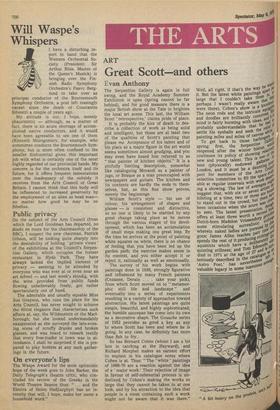ART
Great Scott and others
Evan Anthony
The Serpentine Gallery is again in full swing, and the Royal Academy Summer Exhibition is open (spring cannot be far behind), and for good measure there is a major British show at the Tate to brighten the local art scene. This last, the William Scott ' retrospective,' claims pride of place.
It is probably the kiss of death to describe a collection of work as being solid and intelligent, but those are at least two of the qualities of Scott's painting that please me. Acceptance of his talent and of his place as a major figure in the art world seems sometimes almost grudging, and you may even have heard him referred to as " that painter of kitchen objects." It is a pitifully limiting description, somewhat like cataloguing Morandi as a painter of jugs, or Braque as a man preoccupied with newspapers and guitars. The kitchen and its contents are hardly the ends in themselves, but, as this fine show proves, merely the beginnings.
William Scott's style — his use of colour, his arrangement of shapes and planes — is consistent and distinctive, so no one is likely to be startled by any great change taking place as he moves through the various stages of his development, which has been an accumulation of small steps making one great leap. By the time he arrives at the point of painting white squares on white, there is no chance of feeling that you have been led up the garden path; the exercise makes sense in its context, and you either accept it or reject it, rationally as well as emotionally.
The survey of his work begins with paintings done in 1938, strongly figurative and influenced by many French painters (Cezanne, Derain . . . take your pick), from which Scott moved on to "metamorphic still life and landscape" and eventually into a series of experiments resulting in a variety of approaches toward abstraction. His latest paintings are quite simple, beautiful, and highly sophisticated; the humble saucepan has come into its own as a decorative shape. The Gouache series of 1952 provides as good a key as any to where Scott has been and where he is going. In any case, he definitely has more than fish to fry.
So has Bernard Cohen (whom I am a bit late in catching at the Hayward), and Richard Morphet makes an earnest effort to explain in his catalogue notes where Cohen is at. Thus: "The ` white ' paintings of 1966-70 are a reaction against the idea of a major work.' Their rejection of image in favour of self-referential process is underlined by Cohen's making the works so large that they cannot be taken in at one look, and by his attraction to the idea that people in a room containing such a work might not be aware that it was there." W. ell, all right, if that's the way he Wftalloots aP lit. But the latest white paintings a or rge that I couldn't take them 'll'they perhaps I wasn't really aware that were there), Cohen's show is a loW Tc"les he neon rods and the intricate Willis and doodles are brilliantly contrived. 05 mind is fairly bursting with ideas, an jd to probably understandable that h11 Of settle his eyeballs and seek the relw,te. painting miles and miles of canvas vitsiii of To get back to those harbiherY, spring: first, the Serpentine 'woe reopened after the winter hiatus, iveli continues its policy of showing rela1 t; the new and young talent. This is one 010 best (physically) endowed galleriesnre London, and it must be a daunting°o !, ril pect for members of the Arts asraii' selection committee to fill the sPaifecieseri" able at regular intervals with Ivor", iright ing a showing. The law of average'.450: suggest that, with six or seven 3rt1;n000 hibiting at a time, two or three are 'lore to stand out in the crowd, but therecoef been occasions when the score Wastbough to zero. The latest presentation, `ci 10014: offers at least three worth a sec°„Provides Dutch-born Madelon VriesendcorP some stimulating surrealistic e„ wherein naked ladies are pursued.''e ono gons; James Allen teaches Part spends the rest of it producing etchili aquatints which have a deliberatecii; vitio quieting stillness; and Tom Ech11°Ari is died in 1971 at the age of 27 ari" e aS teriously described in the catalog.' left 'Astro Poet,' has nevertheless ,,rroof valuable legacy in some ingenious Illwient Of glass sheets embellished with -Lraset, and witty formations of type. Scanewhat less determinedly ex-1 Pieriniental, at least in policy, the Royal uca"cletnY (do I hear you sniggering?) also thSZ 4 eeninlittee to make its selections for d.` annual summer show. Considering the ttsdain a e Acaidnernwy Which so many purport to hold it's remarkable how many wrtirst,ts of all ages and dispositions submit 1,2%71' This year's collection has close to thre",.13ieees neatly arranged to dispel any lea;:` of claustrophobia. There is at 40:" nue piece of sculpture I would like to clg" James Butler's Portrait of Kate, Poe "ye, a charming, old-fashioned (I supEdle) bit _of work, and several paintings. spiWaln" Wakeford has a few of the dabIria,;'' school, with the control of a turnier; Norman Blarney's cold, architec thalPictures: intrigue me; Ruskin Spear eksts With his portrait of Lord Goodman gertiZ,4g men have great character, and sho 12-'he Hermes's drawings of elephants V'fhlvat`,,"at big animals can have great grace. pre Ore do YOU want for 40p? 4, he'r,,at Roland, Browse and Delbanco, is laletner.",,narY exhibition celebrating the recia: °I. William Nicholson. One can a,ppNichte the catalogue comment, ' ... tallts°1s°n May be termed a painter 'who I° 0141 Whispers,' but it is not necessary thoseolit in order to have quality." For \storirkWho admire quality, and for any who llerj i'r at the word means when aPPStreet() a Painting, a visit to this Cork eXhibition is in order. 1..11\ltNIA











































 Previous page
Previous page